

VMware View 4.5 Storage Tiering explained. The NDA for VMware View 4.5 has been lifted and I would like talk a little bit about an important new storage feature released with View 4.5 – Tiered Storage.

Tiered Storage allow administrators to select the most adequate Datastore for a given type of disk (.vmdk) and/or workload. In the past I have written about how VMware View Composer works and how base image, replicas and linked clones are created and maintained. If you would like to read the entire article click at “Real Life example of Storage Sizing for View Linked Clones”, otherwise let’s quickly review. Master Replica – The Master Replica is a one off for each SOE used as template. Unless the homework has not been properly done there shouldn’t be many Master Replicas. VMware View 4.5 introduces the following new disks: Persistent Disk – This is the old User Data Disk that has been renamed.
VMworld 2014 VMware vCloud Air and ViPR Object Storage. This one is short and sweet!
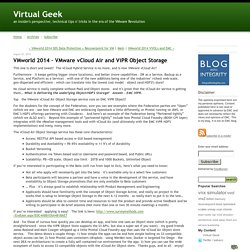
The vCloud Hybrid Service is no more, and is now VMware vCloud Air! Furthermore – it keeps getting bigger (more locations), and better (more capabilities – DR as a Service, Backup as a Service, and Platform as a Service) – with one of the new additions being one of the industries’ richest web-scale, geo-dispersed and efficient - which can translate into the lowest cost model – object (and HDFS!) Store! VMware Storage Integration & Top Storage Vendors. Research done in collaboration with Stuart Miniman and Nick Allen Introduction In April 2011 Wikibon ran a survey looking at the area of storage and VMware.

The results showed that EMC and NetApp had a clear lead in the number of respondents that selected them as the best VMware storage and as the primary VMware storage vendor. Wikibon has further analyzed the results of the survey, including a detailed analysis of the degree of integration. The findings of this analysis were similar to the first report, that EMC and NetApp were the leading storage vendors in integration of storage and VMware. Figure 1 – Relative Positioning of VMware Storage Integration by VendorSource: Wikibon Survey April 2011, n=361, and detailed analysis of vendor implementations. Wikibon believes that practitioners can use the methodology in this report to help position the importance of integration features for their own VMware storage decisions and to help decide which vendors to include in RFPs.
Conclusions. VMware's Virtual SAN Threatens Traditional Data Storage Models. VMware has launched the final part of its software defined data center puzzle: a virtual SAN product called Virtual SAN.
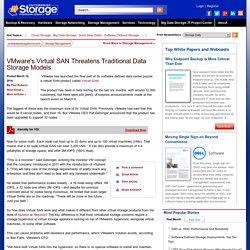
The product has been in beta testing for the last six months, with around 12,000 customers, but there were still plenty of surprise announcements made at the launch event on March 6. The biggest of these was the maximum size of its Virtual SAN. Previously VMware had said that this would be 8 server nodes, and then 16. But VMware CEO Pat Gelsinger announced that the product has been upgraded to support 32 nodes. Now for some math. "This is a monster," said Gelsinger, echoing the monster VM concept that the company introduced in 2011 with the introduction of vSphere 5. He added that performance scales linearly - a 16 node setup offers 1M IOPS, a 32 node one offers 2M IOPS - and despite his previous comment about 32 nodes being monstrous, he hinted that even larger Virtual SANs are on the roadmap: "There will be more in the future.
It turns out that there's two ways. Storage and Server Virtualization from DataCore and VMware. Experience SANs with the highest availability, fastest performance and fullest utilization Virtually everything hinges on storage.
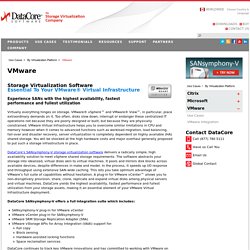
VMware® vSphere™ and VMware® View™, in particular, place extraordinary demands on it. Too often, disks slow down, interrupt or endanger these centralized IT operations not because they are poorly designed or built, but because they are physically constrained. VMware Virtual Infrastructure helps you to overcome similar limitations in CPU and memory however when it comes to advanced functions such as workload migration, load balancing, fail-over and disaster recovery, server virtualization is completely dependent on highly available (HA) shared storage.
You will be shocked at the high hardware costs and major overhaul generally proposed to put such a storage infrastructure in place. DataCore's SANsymphony-V storage virtualization software delivers a radically simple, high availability solution to meet vSphere shared storage requirements. Converged Storage for VMware. Imagine what you can achieve by combining the power of VMware vSphere with storage platforms designed to eliminate the challenges of server and client virtualization.
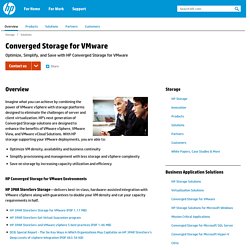
VMware Storage and Software-defined Storage (SDS) Solutions Blog Posts. Oregon State University, a public institution with more than 26,000 students and growing VDI workloads wanted a high performance storage tier for their VDI environment.
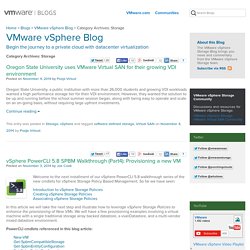
However, they wanted the solution to be up and running before the school summer session began, along with being easy to operate and scale on an on-going basis, without requiring large upfront investments. Continue reading Welcome to the next installment of our vSphere PowerCLI 5.8 walkthrough series of the new cmdlets for vSphere Storage Policy Based Management. So far we have seen: Software-Defined Storage (SDS) and Storage Virtualization.
VMware vSphere: Storage Virtualization & Storage Management. Page 2 - VMware Builds Out Virtualization for Servers, Storage, Networking.